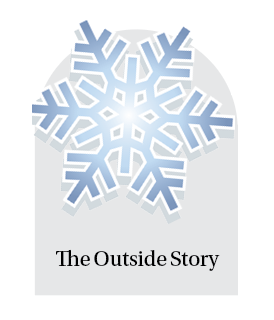
By Colby Galliher
It’s deep in winter, and a nor’easter is dumping snow outside. In between the howling winds you hear a boom! Maybe a heap of snow fell from the roof, you think, or a giant icicle crashed from the eaves. A few minutes later, another boom pounds through the blizzard’s gales. It’s closer this time, and it seems to resound from the sky. This booming may be a rare wintertime phenomenon: thundersnow.
While most of us equate thunderstorms with hot, humid summer weather, they can also happen during the winter. Thundersnow is, simply, a type of thunderstorm where precipitation falls as snow rather than rain. The thunder and lightning of a thundersnow storm result from the same factors that cause rainy thunderstorms. Regardless of the season, lightning in any storm requires electrical charge separation, explains Peter Banacos, science and operations officer at the National Weather Service in Burlington.
“Charge separation comes about when you have what is called a ‘mixed-phase’ region within a cloud and strong vertical motions – think updrafts and downdrafts – in tall, cumulonimbus clouds,” Banacos says. “The mixed-phase would be a combination of rain droplets, graupel, and snow within a portion of the cloud.” The winds of a powerful winter storm smash those condensates together, he explains, “stripping electrons and charging those particles positive or negative.” The storm cloud, now stratified into positively and negatively charged regions, may emit an electrical discharge in the form of lightning, which then generates a thunderclap.
Thundersnow, unlike the thunderstorms typical of spring and summer in the Northeast, is uncommon. It owes its rarity to the general meteorological conditions of winter. “Air temperatures are colder, the sun angle is low, and moisture is more limited” in winter, Banacos notes. “Without that instability in the atmosphere, you don’t get the magnitude of vertical motion necessary to develop the charge separation within a cloud.” No charge separation means no lightning – and no thundersnow.
That’s why you’re most likely to experience thundersnow during the Northeast’s strongest storms. Only the meteorological chaos of a nor’easter – when gale force winds gust from the northeast, often coupled with heavy precipitation – is powerful enough to introduce the necessary atmospheric instability for thundersnow when temperatures are cold enough for snow, rather than rain, to fall. Banacos says that the same instability favorable to thundersnow’s formation is associated with heavy snowfall rates of up to 2 inches per hour.
But not every nor’easter or other powerful winter storm produces thundersnow. Very specific criteria must align for thundersnow to arise. Banacos estimates that thundersnow occurs in northern New England only once every year or two. He recalls two recent days when his office tracked thundersnow in Vermont: across the northern portions of the state on Nov. 15, 2019, and again on March 29, 2023. Even as a meteorologist, he has only witnessed thundersnow firsthand twice in his life, in instances two decades apart.
Thundersnow bears another characteristic that distinguishes it from warm-weather thunderstorms. Because thundersnow usually occurs during high-intensity snowstorms, falling snow often acts as an acoustic dampener. Rather than the distinct clap of summer thunder, which may be heard from miles away, thundersnow is more muffled; its boom is often only detectable within a mile or two of the storm’s eye.
Despite thundersnow’s muffled acoustics, these winter events can be dangerous. Accounts collected by the Washington Post, for example, describe people being struck by lightning during thundersnow. One details thundersnow lightning blasting a hole in the side of a house in Rhode Island, while another describes one strike injuring several people at a bus stop in Illinois.
Just like a nor’easter, thundersnow is most safely and prudently enjoyed from the refuge of your home. If you hear a thunderous boom while a nor’easter blows outside, take heed: you may bear witness to an exceedingly rare meteorological phenomenon.
Colby Galliher is a writer who calls the woods, meadows, and rivers of New England home. To learn more about his work, visit colbygalliher.com. Illustration by Adelaide Murphy Tyrol. The Outside Story is assigned and edited by Northern Woodlands magazine and sponsored by the Wellborn Ecology Fund of the New Hampshire Charitable Foundation: nhcf.org.

